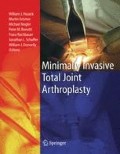Abstract
The concept of minimizing soft-tissue invasion during the surgical approach to the knee is not new. In fact, the subvastus muscle-sparing approach was originally described in 1929 by Erkes [6]. The proposed advantages of this approach were the reduction of post-operative pain and a more rapid recovery of motion. Over the next 40 years, there were few references to this technique in the American literature [1, 9]. Interest in the subvastus approach has been rekindled over the past decade as surgeons and patients have begun to focus their interests on improving the rate of recovery after knee arthroplasty. An internet search of the literature in 2004 (PubMed medline query) yielded 17 citations concerning the effect of the approach on total knee recovery published since 1991, and 11 of those have been written in the past 4 years.
Access this chapter
Tax calculation will be finalised at checkout
Purchases are for personal use only
Preview
Unable to display preview. Download preview PDF.
References
Abbott L.C., Carpenter W.F. (1945). Surgical approaches to the knee joint. J Bone Joint Surg 27 (2):277–310
Bindelgias D.F., Vince K.G. (1996). Patellar tilt and subluxation following subvastus and parapatellar approach in total knee arthroplasty: implication for surgical technique. J Arthroplasty 11 (8): 507–511
Chang C.H., Chen K.H., Yang R.S., Liu. TK (2002) Muscle torques in total knee arthroplasty with subvastus and parapatellar approaches. Clin Orthop 398:189–195
Cila E, Guszel V, Ozalay M,Tan J, Simsek S (2002) Subvastus versus medial parapatellar approach in total knee arthroplasty. Arch Orthop Trauma Surg 122:65–68
Engh GA (2001) Complications after total knee arthroplasty: Prevention and management. AAOS, San Francisco
Erkes F (1929) Weitere Erfahrungen mit physiologischer Schnit- tfuhrung zur Eroffnung des Kniegelenks. Bruns Beitr Klin Chir 147: 221–232
Faure BT, Benjamin JB, Lindsey B., Volz RG, Shutte D (1993) Comparison of the subvastus and paramedian surgical approaches in bilateral knee arthroplasty. J Athroplasty 8 (5): 511–516
Furia JP, Pelligrini VD (1995) Heterotopic ossification following primary total knee arthroplasty. J Arthroplasty 10 (4): 413–419
Gustke K, Smigielski M (1989) The southern approach to the knee. Journal of the Florida Orthopedic Society, Summer 1989
Hasegawa M, Ohashi T, Uchida A (2002) Heterotopic ossification around distal femur after total knee arthroplasty. Arch Orthop Trauma Surg 122 (5): 274–278
Hoffman AA, Plaster RL, Murdock LE (1991) Subvastus (Southern) approach for primary total knee arthroplasty. Clin Orthop 269: 70–77
Kayler DE, Lyttle MB (1988) Surgical interruption of patella blood supply by total knee arthroplasty. Clin Orthop 229: 221
Matsueda M, Gustilo RB (2000) Subvastus and medial parapatellar approaches in total knee arthroplasty. Clin Orthop 371: 161–168
Ogata K, Ishinishi T, Hara M (1997) Evaluation of patellar retinacular tension during total knee arthroplasty: special emphasis on lateral retinacular release. J Arthroplasty 12 (6): 651–656
Peters PC, Kenezevich S, Engh GA, Preidis FE, Dwyer KA (1992) Comparison of subvastus quadriceps-sparing and standard quadriceps-splitting approaches in total and unicompartmental knee arthroplasty. Orthop Trans 16: 146
Petrella JK, Cress ME, Bickel CS, Ferrara MS, Mahoney OM, Dudley GA (2004) Knee joint pain, quadriceps femori, and physical function 3 months after total knee arthroplasty. In press
Rader CD, Barthel T, Haase M, Setzeider M, Eulert J (1997) Heterotopic ossification after total knee arthroplasty. Acta Orthop Scand 68 (1): 46–50
Roysam GS, Oakley MJ (2002) The subvastus approach for total knee arthroplasty resulted in better short term outcomes. JBJS 84A (2): 325
Roysam GS, Oakley MJ (2001) Subvastus approach for total knee arthroplasty. J Arthroplasty 16 (4): 454–457
Scheibel MT, Schmidt W., Thomas M, von Sulls Soglin G (2002) A detailed anatomical description of the subvastus region and its clinical relevance for the subvastus approach in total knee arthroplasty. Surg Radiol Anat 24: 6–12
Whiteside LA, Ohl MD (1990) Tibial tubercle osteotomy for exposure of the difficult total knee arthroplasty. Clin Orthop 260: 6–9
Editor information
Editors and Affiliations
Rights and permissions
Copyright information
© 2004 Springer Medizin Verlag Heidelberg
About this chapter
Cite this chapter
Mahoney, O.M. (2004). The Subvastus Approach in Total Knee Arthroplasty. In: Hozack, W.J., et al. Minimally Invasive Total Joint Arthroplasty. Springer, Berlin, Heidelberg. https://doi.org/10.1007/978-3-642-59298-0_24
Download citation
DOI: https://doi.org/10.1007/978-3-642-59298-0_24
Publisher Name: Springer, Berlin, Heidelberg
Print ISBN: 978-3-642-63926-5
Online ISBN: 978-3-642-59298-0
eBook Packages: Springer Book Archive

